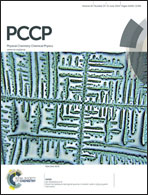Excited state deactivation pathways of neutral/protonated anisole and p-fluoroanisole: a theoretical study†
Abstract
The potential energy profiles of neutral and protonated anisole and p-fluoroanisole at different electronic states have been investigated extensively by the RI-MP2 and RI-CC2 methods. The calculations reveal that the relaxation dynamics in protonated anisole and p-fluoroanisole are essentially different from those of the neutral analogues. In neutral anisole/p-fluoroanisole, the 1πσ* state plays a vital relaxation role along the O–CH3 coordinate, yielding the CH3 radical. For both of these molecules, the calculations indicate conical intersections (CIs) between the ground and excited state potential energy (PE) curves, hindered by a small barrier, and providing non-adiabatic gates for radiation-less deactivation to the ground state. Nevertheless, for the protonated cases, besides the prefulvenic deformation of the benzene ring, it has been predicted that the lowest 1(σ,n)π* state along the C–O–C bond angle plays an important role in photochemistry and the relaxation dynamics. The S1, S0 PE profiles of protonated anisole along with the former reaction coordinate (out-of-plane deformation) show a barrierless relaxation pathway, which can be responsible for the ultrafast deactivation of excited systems to the ground state via the low-lying S1/S0 conical intersection. Moreover, the later reaction coordinate in protonated species (C–O–C angle from 120°–180°) is consequently accompanied with the bond cleavage of C–OCH3 at the 1(σ,n)π* state, hindered by a barrier of ∼0.51 eV, and can be responsible for the relaxation of excited systems with significant excess energy (hν ≥ 5 eV). Furthermore, according to the RI-CC2 calculated results, different effects on the S1–S0 electronic transition energy of anisole and p-fluoroanisole upon protonation have been predicted. The first electronic transitions of anisole and p-fluoroanisole shift by ∼0.3 and 1.3 eV to the red respectively due to protonation.


 Please wait while we load your content...
Please wait while we load your content...